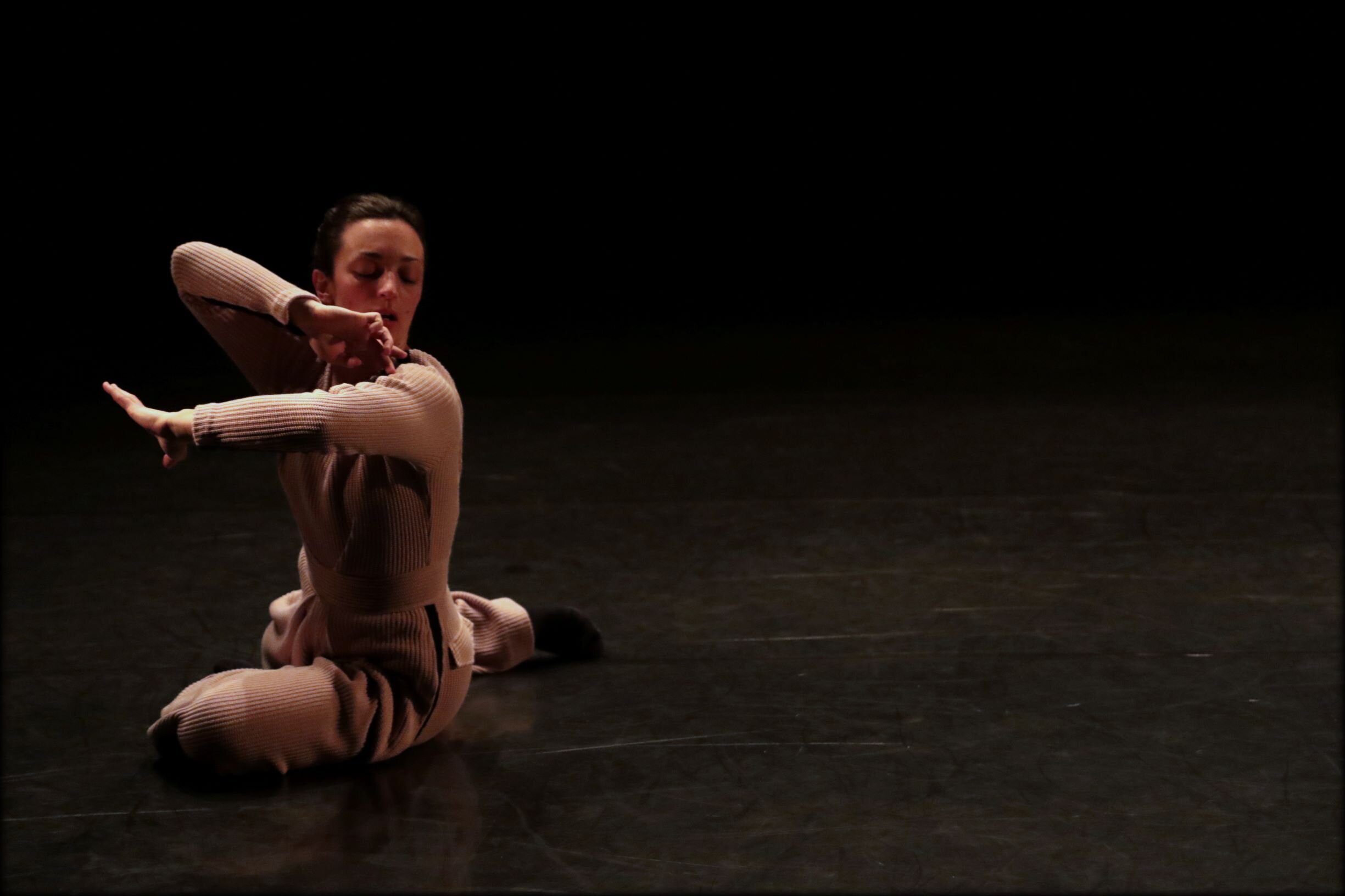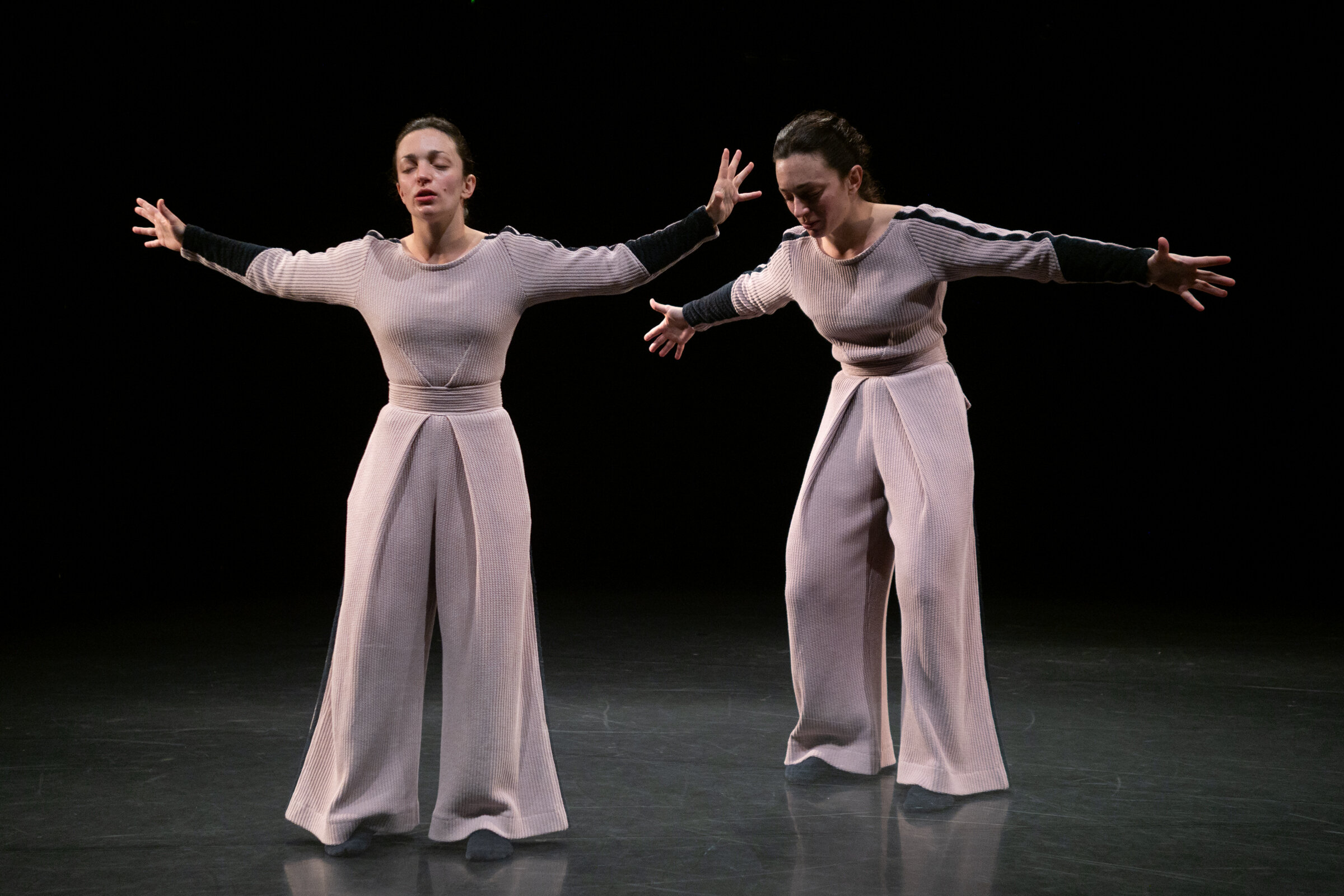Jerca Rožnik Novak & Johannes Randolf
2GETHER/AL(L)ONE / SKUPAJ POPOLN(OM)A SAMA
plesna predstava / a dance performance
Koncept in koreografija / Concept & Choreography: JERCA ROŽNIK NOVAK & JOHANNES RANDOLF
Izvajalki / Performers: JERCA ROŽNIK NOVAK & VERONIKA
Avtorska glasba / Music: MATEVŽ KOLENC
Kostumografija / Costume Design: ANDREJ VRHOVNIK
Dramaturgija / Dramaturgy: URŠA ADAMIČ
Oblikovanje svetlobe / Lighting Design: JANKO OVEN
Svetovanje za igro / Acting Advice: ZALA ANA ŠTIGLIC
Avtorica ilustracij / Illustrations: DORA BENČEVIČ
Kreativna in izvršna producentka / Creative & Executive Producer: KATJA SOMRAK
Produkcija / Produced by: PLESNI TEATER LJUBLJANA
Koprodukcija / Co-Produced by: ASSOCIAZIONE CULTURALE CAPOTRAVE / KILOWATT, DUBLIN THEATRE FESTIVAL COMPANY LIMITED BY GUARANTEE, GÖTEBORGS STADS KULTURFÖRVALTNING/ STORA TEATERN, BAKELIT MULTI ART CENTER
Realizacija v okviru EU projekta Be SpectACTive! 2 / Realized in the framework of the European project Be SpectACTive!2 – CapoTrave/Kilowatt (IT), Artemrede (PT), Bakelit Multi Art Center (HU), brut (AT), Buda Kunstencentrum Kortrijk (BE), CdAT- Cafè de las Artes Teatro (ES), Domino (HR), International Theatre Festival Divadelná Nitra (SK), Dublin Theatre Festival (IE), Stora Teatern / Gothenburg Dance and Theatre Festival (SE), SKCNS - Institution Student Cultural Centre OF Novi Sad (RS), Occitanie en scène Languedoc-Roussillon (FR), Plesni Teater Ljubljana (SI), Tanec Praha (CZ), Teatrul National Radu Stanca Sibiu (RO), Fondazione Fitzcarraldo (IT), Universitat de Barcelona (ES), Université de Montpellier (FR), CNRS (FR)
V sodelovanju / In collaboration with: C. O. V. CIE OFF VERTICALITY
S podporo / Supported by: THE CREATIVE EUROPE PROGRAMME OF THE EUROPEAN UNION
Zahvale / Thanks to: VERONIKA TÖKÖLY, WILLIE WHITE, SARAH MELIN, ZSÓFIA VASI, TILEN MEJAČ & udeleženci / participants Dublin: MIA DICHIARO, PIPPA MOLON, ENYA BELAK GUPTA, MAUD HENDRICKS, MARIE O'CONNOR, CARMEL ENNIS, FABIANO ROGGIO, NANDA GRIFFIOEN, RODRIGO PRAYEDES RICALLICE, GRĀINNE HOLMES BLUMENTHAL, AOIFE CONNOLLY SULLIVAN; udeleženci / participants Göteborg: KARIN JOHANSSON, MARINA JEVDJENIC, SARA JOHNSON, ANNA SILVÉN, DEEPATI FORSBERG, LINDA BRELIN, LEX ELIOT, LINNEA JARDEMAR, PETRA HELLBERG, NAN ALBERTSSON, MICAELA BANEGA, PETER SANDSJÖ, ÅSA SANDSJÖ, FIDELI GONDENSEN, CARINA KARVANEN, SUSANNA LINDSTRÖM, MONICA FURU ELIASSON, MONA HANSSON, KARINA GUSTAFSSON, LINDA LILIAC, PATRIK JONSSON, HELENA WALLIN, študenti / students from Nordiska Folkhögskolan; udeleženci / participants Budapest: ÁBRAHÁM DOMONKOS, DUMA LILLA, LAKY BOGLÁRKA, TISZA TAMÁS, ILOSVAI DÁNIEL, PORDÁN ANNASÁRA, KOVÁCS VERONIKA, BOZSIK BELLA, NÁDOR ESZTER, BALOGH REBEKA, GYŐRBÍRÓ CSENGE, LABUS LILI, SZAKMÁRY LUCÁNAK, CZENTE ILONA, NAGY JÚLIA, SZUKY GERGŐ, SILVIA GUERRERO ROSA
Program Plesnega Teatra Ljubljana sofinancirata Ministrstvo za kulturo RS in Mestna občina Ljubljana, Oddelek za kulturo / The programme of Plesni Teater Ljubljana is subsidized by the Ministry of Culture RS and Municipality of Ljubljana, Department for Culture
Foto / Photo: SUNČAN PATRICK STONE, DRAGO VIDEMŠEK
O predstavi
Predstava temeljito poudarja občutek samote, čeprav je spomin na dvojino še vedno zelo prisoten. Raziskovanje odnosa v dvoje in občutka samote vodi v odkrivanje različnih načinov spreminjanja odsotnosti. Praznina ponuja prostor za soustvarjanje dueta med plesalkama Jerco Rožnik Novak in Veroniko.
Iz nepredvidljivega razvita koreografija
Gledališče hodi po robu kaosa. Občinstvo v zavetju teme dvorane opazuje spretna telesa, ki na odru utelešajo neko vnaprej določeno dogajanje. Zaupajo, da je zadaj načrt, koreografija, scenarij, dramski tekst, da so nastopajoči svoje delo vnaprej pripravili in vadili. Bolj ko je uprizoritvena forma načrtovana in rigidna, bolj rušilno nanjo delujejo morebitne napake, ki odrsko iluzijo razbijejo in učinkujejo kot vdor realnega. V plesnem duetu 2GETHER/AL(L)ONE pa je realno v gledališki situaciji prisotno od samega začetka.
Prisotnost tolikšnega števila ljudi na enem mestu je vedno nepredvidljiva, pa vendar je ravno ta situacija ključna za nastanek predstave, oziroma, kot zapiše Nicholas Ridout v svoji knjigi Stage Fright, Animals, and Other Theatrical Problems: »...ljudje, ki so med seboj so-prisotni v gledališkem okolju, so vedno živi, tovrstna izmenjava, ne glede na to, kako nerodna je in kako se ji želimo izogniti, je vedno že tam. So-prisotnost je vgrajena v samo strukturo celotne gledališke situacije«. Gledališče vedno vključuje toliko človeških dejavnikov, da ne more biti popolnoma predvidljivo. Ridout gre v svoji analizi gledaliških napak še dlje in zapiše, da je prav napaka v gledališču nekako sestavni del vsake predstave in posledično njegovega obstoja. Napake, kot so nenadzorovani smeh, trema, občutek sramu, živali, otroci in druge, ohranjajo vitalnost gledališča, saj je to predvsem umetnost trenutka tukaj in zdaj. Ob ogledu predstave tudi gledalci sprejmemo svojo vlogo in ne glede na to, kaj točno naredimo, igramo gledališke gledalce. Na ta način torej že ob vstopu v fizičen prostor gledališča postanemo tudi nastopajoči.
Na tem zavedanju gradi tudi predstava 2GETHER/AL(L)ONE. Gledalce postavi v čevlje napake. Nepredvidljivost odrske situacije razvije naprej in poudari pomembno mesto občinstva. Iz neprijetne in nepričakovane poškodbe, iz občutka strahu pred zapuščenostjo, je nastala neponovljiva gledališka izkušnja. Vedno znova je performativni prostor soočen z nepredvidljivo situacijo odsotnosti. Odsotnost postane izhodišče nove prezence. Gledališče pač potrebuje gledalce, gledalke in nastopajoče, ne glede na to, katero vlogo kdaj igrajo.
Urša Adamič
About the performance
The performance strongly emphasizes the feeling of being left alone, although the memory of togetherness is still very present. Exploring the relation between the two leads to discovering new ways of changing the absence. The emptiness offers a platform for the co‑creation of the duet between Jerca Rožnik Novak and Veronika.
Choreography developed from the unpredictable
Theatre stands on the edge of chaos. Under the cover of darkness, the audience observes the skilful bodies that embody on stage a predetermined course of events. They trust that there is an underlying plan, choreography, script, dramatic text, that the performers prepared and rehearsed their roles in advance. The more the stage form is planned and rigid, the more destructive potential mistakes may prove to be, the mistakes that break the stage illusion and act as an intrusion of the real. In the dance duet 2GETHER/AL(L)ONE, however, the real is present in the theatre situation from the very beginning.
The presence of so many people in one place is always unpredictable, and yet it is this situation that is vital to the development of the performance, or, as Nicholas Ridout puts it in his book Stage Fright, Animals, and Other Theatrical Problems: “[P]eople who are co-present to each other in the theatrical set-up are always alive, this kind of interchange, however embarrassing, however much we seek to avoid it, is always already there, built into the structure of ‘the entire situation’.” Theatre always involves so many human factors that it cannot be entirely predictable. In analysing theatrical mistakes, Ridout goes one step further, noting that in theatre, the mistake itself is somehow an integral part of every performance and, therefore, of its existence. Mistakes such as uncontrollable laughter, stage fright, feelings of shame, animals, children, and others maintain the vitality of theatre, as it is primarily the art of here and now. When watching the performance, the viewers themselves assume our role of theatre audience, regardless of what exactly we do. In doing so, we, too, become performers as we enter the physical space of the theatre.
2GETHER/AL(L)ONE also builds on this awareness. It puts the audience in the shoes of mistake. It further develops the unpredictability of the situation on stage, highlighting the important role of the audience. Out of the unpleasant and unexpected injury, from a sense of fear of abandonment emerged a one of¬ a kind theatre experience. Time and again, the performative space is faced with the unpredictable situation of absence. Absence becomes the starting point of the new presence. After all, theatre needs viewers and performers, no matter what role they are playing or when.
Urša Adamič



